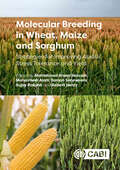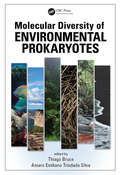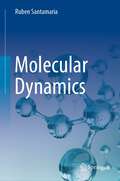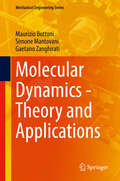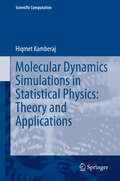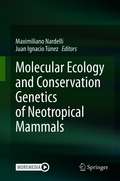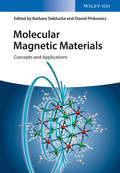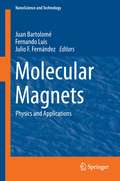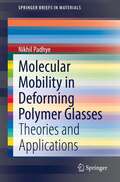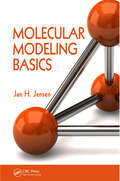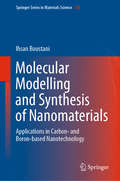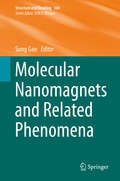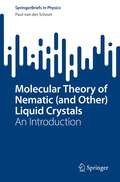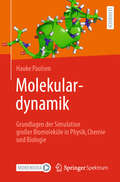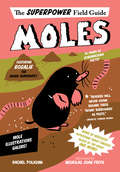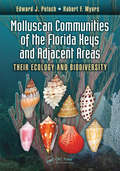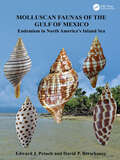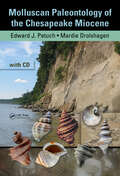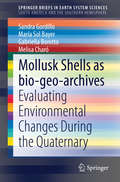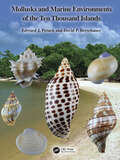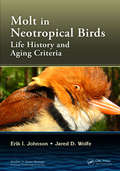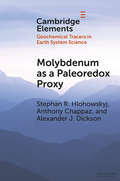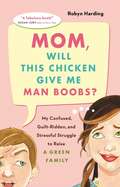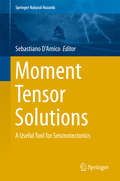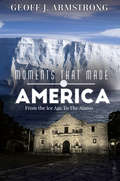- Table View
- List View
Molecular Breeding in Wheat, Maize and Sorghum: Strategies for Improving Abiotic Stress Tolerance and Yield
by Pradeep Kumar Natasha Sharma Shabir Hussain Wani Santosh Kumar Muhammad Sarwar Khan Charan Singh Rod Snowdon Pardeep Kumar Professor David Edwards Andrea Acuna Muhammad Amjad Ali John Amalraj Maria Arguello Arushi Arora Diana Ballesteros Bhoja R Basnet Salma Bhyan Richard Boyles Faïçal Brini Yibo Cao S Antony Ceasar Nidhi Chakma Subhadra Chakrabarty Moutoshi Chakraborty Harmeet Singh Chawla Dharampal Choudhary Mukesh Choudhary M C Dagla Mônica Furaste Danilevicz Abhijit Kumar Das Haixiao Dong Kate Dreher Susanne Dreisigacker Xiaorong Fan Maria Laura Federico Cassandria Tay Fernandez Ertugrul Filiz Monika Garg Claudia Teixeira Guimaraes Karama Hamdi K Hariprasanna Firoz Hossain Guanghui Hu Zhaorong Hu B S Jat Caifu Jiang Faiz Ahmad Joyia Mehar Kamboj Chikkappa Karjagi Lovenpreet Kaur Emna Khanfir Rajesh Khulbe Bhupender Kumar Firat Kurt Zhao Li Yun-Hua Liu Ningthaipuilu Longmei Damar Lopez-Arredondo Jurandir Vieira de Magalhaes T Maharajan Jacob Marsh R. Esten Mason Clémentine Mercé Ghulam Mustafa Vignesh Muthusamy Sudha K Nair Zhongfu Ni Kazutoshi Okuno Geoffrey Onaga Huiru Peng Jorge Fernando Pereira Sacn Perera Bhukya Prakash Lydia Pramitha P Rajendrakumar Mantena Raju Savaram Vr Rao Ali Razzaq P Sanjana Reddy Trenton Roberts G Victor Roch Umesh R Rosyara Pawan Saini Sindhu Sareen Gajanan Saykhedkar André Schaffasz Armin Scheben Tariq Shehzad Sonia Sheoran Ishwar Singh Prabha Singh Vishal Singh Nithya Subramanian Qixin Sun Madhumal Thayil Vinayan Yiqiao Wang Steffen Windpassinger Kerstin Wydra Yinping Jiao Mingming Xin Ines Yacoubi Pranjal Yadava Yingyin Yao Kuohai Yu Yaping Yuan Pervez Haider Zaidi Hong-Bin Zhang Meiping Zhang Zhiwu Zhang Rajkumar U ZunjareThe global population is projected to reach almost 10 billion by 2050, and food and feed production will need to increase by 70%. Wheat, maize and sorghum are three key cereals which provide nutrition for the majority of the world's population. Their production is affected by various abiotic stresses which cause significant yield losses. The effects of climate change also increase the frequency and severity of such abiotic stresses. Molecular breeding technologies offer real hope for improving crop yields. Although significant progress has been made over the last few years, there is still a need to bridge the large gap between yields in the most favorable and most stressful conditions. This book: - Provides a valuable resource for wheat, maize and sorghum scientists working on breeding and molecular biology, physiology and biotechnology. - Presents the latest in-depth research in the area of abiotic stress tolerance and yield improvements. - Contains the necessary information to allow plant breeders to apply this research to effectively breed new varieties of these crops. It provides a consolidated reference for plant breeders and crop scientists working on the challenges of enhanced crop productivity and climate change adaptability.
Molecular Diversity of Environmental Prokaryotes
by Thiago Bruce Rodrigues and Amaro Emiliano Trindade SilvaThis book correlates the vast genetic diversity associated with environmental samples and still underexploited potential for the development of biotechnology products. The book points out the potential of different types of environmental samples. It presents the main characteristics of microbial diversity, the main approaches used for molecular characterization of the diversity, and practical examples of application of the exploration of the microbial diversity. It presents a not-yet-explored structure for discussing the main topics related to molecular biology of environmental prokaryotes and their biotechnological applications.
Molecular Dynamics
by Ruben SantamariaThis molecular dynamics textbook takes the reader from classical mechanics to quantum mechanics and vice versa, and from few-body systems to many-body systems. It is self-contained, comprehensive, and builds the theory of molecular dynamics from basic principles to applications, allowing the subject to be appreciated by readers from physics, chemistry, and biology backgrounds while maintaining mathematical rigor. The book is enhanced with illustrations, problems and solutions, and suggested reading, making it ideal for undergraduate and graduate courses or self-study. With coverage of recent developments, the book is essential reading for students who explore and characterize phenomena at the atomic level. It is a useful reference for researchers in physics and chemistry, and can act as an entry point for researchers in nanoscience, materials engineering, genetics, and related fields who are seeking a deeper understanding of nature.
Molecular Dynamics - Theory and Applications (Mechanical Engineering Series)
by Maurizio Bottoni Simone Mantovani Gaetano ZanghiratiThis book originated from seminars given at the Institute of Nuclear Energy Technology (INET) of Tsinghua University, China, by the author in 1999. The courses gave graduate students a basic understanding of numerical techniques that would enable them to deal with problems of Computational Fluid Dynamics (CFD) and of molecular dynamics at research level. In subsequent years the lecture notes have been re-organized and implemented for students of atmospheric sciences of the Physics Department of the University of Ferrara, Italy. The lecture notes are divided into eight chapters, where some chapters are characterized by a scholastic approach. Specifically, Chapter 1 describes the theoretical basis of molecular dynamics, Chapter 2 gives examples of applications, like the Bénard problem; and Chapter 3 presents a summary of applications of DLA (Diffusion Limited Aggregation). The remainder of the book follows a less conventional approach, mainly informed by the author’s experience in the development of computer programs and in teaching. Chapter 4 is dedicated to a comparison of traditional and advanced methods of analysing nuclear safety problems in thermal and fast reactors, Chapter 5 concerns simulation of thermophoresis and aerosol displacement in atmospheric physics, and Chapter 6 discusses thermal confinement of cosmic particles due to thermophoretic forces in space domain. Addressing the recognized difficulty of proceeding from the theoretical formulations found in textbooks to properly working computer programs, and the typically large gap between the theoretical foundation and the final result, Molecular Dynamics - Theory and Applications is ideal for graduate level researchers and practitioners working in the development of codes for simulating physical problems.
Molecular Dynamics Simulations in Statistical Physics: Theory and Applications (Scientific Computation)
by Hiqmet KamberajThis book presents computer simulations using molecular dynamics techniques in statistical physics, with a focus on macromolecular systems. The numerical methods are introduced in the form of computer algorithms and can be implemented in computers using any desired computer programming language, such as Fortran 90, C/C++, and others. The book also explains how some of these numerical methods and their algorithms can be implemented in the existing computer programming software of macromolecular systems, such as the CHARMM program. In addition, it examines a number of advanced concepts of computer simulation techniques used in statistical physics as well as biological and physical systems. Discussing the molecular dynamics approach in detail to enhance readers understanding of the use of this method in statistical physics problems, it also describes the equations of motion in various statistical ensembles to mimic real-world experimental conditions. Intended for graduate students and research scientists working in the field of theoretical and computational biophysics, physics and chemistry, the book can also be used by postgraduate students of other disciplines, such as applied mathematics, computer sciences, and bioinformatics. Further, offering insights into fundamental theory, it as a valuable resource for expert practitioners and programmers and those new to the field.
Molecular Ecology and Conservation Genetics of Neotropical Mammals
by Maximiliano Nardelli Juan Ignacio TúnezAlthough all living beings modify their environment, human beings have acquired the ability to do so on a superlative space-time scale. As a result of industrialization and the use of new technologies, the anthropogenic impact has been increasing in the last centuries, causing reductions in the sizes or the extinction of numerous wild populations. In this sense, from the field of conservation genetics, various efforts have been made in recent decades to provide new knowledge that contributes to the conservation of populations, species, and habitats. In this book, we summarize the concrete contributions of researchers to the conservation of the Neotropical mammals using Molecular Ecology techniques.The book is divided into three major sections. The first section provides an up-to-date review of the conservation status of Neotropical mammals, the applications of the molecular markers in its conservation, and the use of non-invasive and forensic genetic techniques. The second and third sections present, respectively, a series of case studies in various species or taxonomic groups of Neotropical mammals.
Molecular Magnetic Materials: Concepts and Applications
by Barbara Sieklucka Dawid PinkowiczA comprehensive overview of this rapidly expanding interdisciplinary field of research. After a short introduction to the basics of magnetism and molecular magnetism, the text goes on to cover specific properties of molecular magnetic materials as well as their current and future applications. Design strategies for acquiring molecular magnetic materials with desired physical properties are discussed, as are such multifunctional materials as high Tc magnets, chiral and luminescent magnets, magnetic sponges as well as photo- and piezo-switching magnets. The result is an excellent resource for materials scientists, chemists, physicists and crystal engineers either entering or already working in the field.
Molecular Magnets
by Juan Bartolomé Fernando Luis Julio F. FernándezThis book provides an overview of the physical phenomena discovered in magnetic molecular materials over the last 20 years. It is written by leading scientists having made the most important contributions to this active area of research. The main topics of this book are the principles of quantum tunneling and quantum coherence of single-molecule magnets (SMMs), phenomena which go beyond the physics of individual molecules, such as the collective behavior of arrays of SMMs, the physics of one-dimensional single-chain magnets and magnetism of SMMs grafted on substrates. The potential applications of these physical phenomena to classical and quantum information, communication technologies, and the emerging fields of molecular spintronics and magnetic refrigeration are stressed. The book is written for graduate students, researchers and non-experts in this field of research.
Molecular Mobility in Deforming Polymer Glasses: Theories and Applications (SpringerBriefs in Materials)
by Nikhil PadhyeThis book bridges disparate fields in an exploration of the phenomena and applications surrounding molecular mobility in glassy materials experiencing inelastic deformation. The subjects of plastic deformation and polymer motion/interdiffusion currently belong to the two different fields of continuum mechanics and polymer physics, respectively. However, molecular motion associated with plastic deformation is a key ingredient to gain fundamental understanding, both at the macroscopic and microscopic level. This short monograph provides necessary background in the aforementioned fields before addressing the topic of molecular mobility accompanied by macroscopic inelastic deformation in an accessible and easy-to-understand manner. A new phenomenon of solid-state deformation-induced bonding in polymers is discussed in detail, along with some broad implications in several manufacturing sectors. Open questions pertaining to mechanisms, mechanics, and modeling of deformation-induced bonding in polymers are presented. The book’s clear language and careful explanations will speak to readers of diverse backgrounds.
Molecular Modeling Basics
by Jan H. JensenMolecular modeling is becoming an increasingly important part of chemical research and education as computers become faster and programs become easier to use. The results, however, have not become easier to understand. Addressing the need for a "workshop-oriented" book, Molecular Modeling Basics provides the fundamental theory needed to understand
Molecular Modelling and Synthesis of Nanomaterials: Applications in Carbon- and Boron-based Nanotechnology (Springer Series in Materials Science #290)
by Ihsan BoustaniThis book presents nanomaterials as predicted by computational modelling and numerical simulation tools, and confirmed by modern experimental techniques. It begins by summarizing basic theoretical methods, then giving both a theoretical and experimental treatment of how alkali metal clusters develop into nanostructures, as influenced by the cluster's "magic number" of atoms. The book continues with a discussion of atomic clusters and nanostructures, focusing primarily on boron and carbon, exploring, in detail, the one-, two-, and three-dimensional structures of boron and carbon, and describing their myriad potential applications in nanotechnology, from nanocoating and nanosensing to nanobatteries with high borophene capacity. The broad discussion of computational modelling as well as the specific applications to boron and carbon, make this book an essential reference resource for materials scientists in this field of research.
Molecular Nanomagnets and Related Phenomena
by Song GaoThe series Structure and Bonding publishes critical reviews on topics of research concerned with chemical structure and bonding. The scope of the series spans the entire Periodic Table and addresses structure and bonding issues associated with all of the elements. It also focuses attention on new and developing areas of modern structural and theoretical chemistry such as nanostructures, molecular electronics, designed molecular solids, surfaces, metal clusters and supramolecular structures. Physical and spectroscopic techniques used to determine, examine and model structures fall within the purview of Structure and Bonding to the extent that the focus is on the scientific results obtained and not on specialist information concerning the techniques themselves. Issues associated with the development of bonding models and generalizations that illuminate the reactivity pathways and rates of chemical processes are also relevant. The individual volumes in the series are thematic. The goal of each volume is to give the reader, whether at a university or in industry, a comprehensive overview of an area where new insights are emerging that are of interest to a larger scientific audience. Thus each review within the volume critically surveys one aspect of that topic and places it within the context of the volume as a whole. The most significant developments of the last 5 to 10 years should be presented using selected examples to illustrate the principles discussed. A description of the physical basis of the experimental techniques that have been used to provide the primary data may also be appropriate, if it has not been covered in detail elsewhere. The coverage need not be exhaustive in data, but should rather be conceptual, concentrating on the new principles being developed that will allow the reader, who is not a specialist in the area covered, to understand the data presented. Discussion of possible future research directions in the area is welcomed. Review articles for the individual volumes are invited by the volume editors. Readership: research scientists at universities or in industry, graduate students Special offer for all customers who have a standing order to the print version of Structure and Bonding, we offer free access to the electronic volumes of the Series published in the current year via SpringerLink.
Molecular Theory of Nematic: An Introduction (SpringerBriefs in Physics)
by Paul van der SchootThis book provides a didactic derivation of the main theories of thermotropic and lyotropic liquid crystals, revealing the common molecular-theoretic framework that underpins both theories. This unified context will help young researchers in coming to grips with the basics of the simplest of liquid crystals, being uniaxial nematic liquid crystals, easing them into the intricacies of more complex forms of such materials irrespective of whether they are thermotropic or lyotropic. The coverage provides a theoretical understanding of the phase behaviour, that is, what drives molecules and particles to spontaneously align themselves, as well as an appreciation of the role of entropy, energy and so on. The focus here is on the main theories for the isotropic-nematic transition, being the Maier-Saupe and the Onsager theories, and how they are derived from a common description, known as (classical) density functional theory (DFT). This book will be a valuable resource for senior undergraduate and graduate students, and experimentalists and engineers who feel intimidated by more formal or rigorous theoretical accounts and textbooks. Exercises at the end of each chapter help the reader to apply the basic concepts also to other types of liquid crystal, in particular the smectic liquid crystal.
Molekulardynamik: Grundlagen der Simulation großer Biomoleküle in Physik, Chemie und Biologie
by Hauke PaulsenDieses Lehrbuch führt ein in die computergestützte Methode die Wechselwirkungen zwischen Atomen und Molekülen durch empirische Potentiale zu beschreiben und deren Dynamik zu berechnen. Besonderheiten:Mittels Einführung und Anwendungsbeispiel werden die Lesenden schrittweise mit grundlegenden Aspekten von klassischen Molekulardynamik-Simulationen großer Biomoleküle vertraut gemacht. Das Ergebnis einer solchen Simulation, die sogenannte Trajektorie, lässt sich in einer anschaulichen Analogie mit einem „Film&“ vergleichen: Dazu gehören im dritten Kapitel als „Akteure&“ die Atome und Moleküle, im vierten als „Filmset&“ die Simulationsboxen, im fünften als „Rollenbeschreibungen&“ die klassischen Wechselwirkungsmodelle für die Atome und im sechsten als „Drehbuch&“ die Algorithmen, die die Bewegungsgleichungen numerisch integrieren. Anschließend erfolgt der Einbezug von Begriffen aus der statistischen Mechanik und ein ausführlicher Anhang liefert für das Verständnis nützliche mathematische und physikalische Grundlagen. Diese kompakte Einführung in klassische Molekulardynamik-Simulationen schließt die Lücke zur Spezialliteratur. Elektronisches Zusatzmaterial wie Videodarstellungen von Simulationen, Strukturdateien von Molekülen und Skripte zur Durchführung von Simulationsrechnungen sollen den Lesenden eine aktive Auseinandersetzung mit dem Lehrstoff erleichtern. Der Inhalt:1. Einleitung – 2. Ein praktisches Beispiele – 3. Atome und Moleküle – 4. Simulationsboxen – 5. Wechselwirkungen – 6. Integration der Bewegung – 7. Ensembles – 8. Thermostate – 9. Barostate Zielgruppe:Dieses Buch bietet Studierenden der Physik, Biologie, Chemie und verwandter Fachgebiete eine grundlegende Einführung. Den Fortgeschrittenen kann es nicht zuletzt wegen der umfangreichen Literaturverweise als Referenz dienen. Vorkenntnisse:Die nötigen physikalischen Grundlagen werden wiederholt, um so jedem Lesenden ein einheitliches Vorwissen zu bieten.
Moles (Superpower Field Guide)
by Rachel PoliquinFunny and fact-filled, MOLES is another installment in the SUPERPOWER FIELD GUIDES series by author Rachel Poliquin, featuring full-color illustrations by Nicholas John Frith that will engage readers with witty narration and fun visual elements, inspiring readers to dig deep and see the world, both above and below ground, with new eyes. Meet Rosalie, a common mole. The first thing you need to know about Rosalie is that she is shaped like a potato. Not a new potato, all cute and round, but a plain old lumpy potato. She may be small. She may be spongy. But never underestimate a mole. I know what you’re thinking: moles are just squinty-eyed beasts that wreck your lawn. You’re right! Those squinty eyes and mounds of dirt are proof that moles have superpowers. There is absolutely nothing common about the common mole.
Molluscan Communities of the Florida Keys and Adjacent Areas: Their Ecology and Biodiversity
by Edward J. Petuch Robert F. MyersMolluscan Communities of the Florida Keys and Adjacent Areas: Their Ecology and Biodiversity is the first comprehensive overview of the ecology and biodiversity of the phylum Mollusca in the area of Florida extending from the Dry Tortugas and Ten Thousand Islands in the west to Palm Beach in the east. The book provides detailed analyses of mollusca
Molluscan Faunas of the Gulf of Mexico: Endemism in North America’s Inland Sea
by Edward J. Petuch David P. BerschauerRecent biodiversity studies, reported here for the first time, have shown that the molluscan fauna of the Gulf of Mexico is far richer and more complex than previously thought. As a result of these new discoveries, the Gulf malacofauna is shown to contain large numbers of endemic species that reside within four separate biogeographical subdivisions of the larger Carolinian Molluscan Province: the Floridian, Suwannean, Texan, and Yucatanean Subprovinces. These four Gulf biotic components, with each supporting its own endemic fauna, are shown here to be separated by distinct ecological and oceanographic barriers. The resultant physical and genetic isolation has led to the evolution of spectacular sibling species radiations, many unknown and undescribed until now. Some of the most conspicuous and important of these are found in the gastropod families Fasciolariidae, Volutidae, Conidae, Muricidae, and Busyconidae, all of which are dominant predators in their respective benthonic ecosystems. The species within these ecologically important families, along with hundreds of endemic taxa in 50 other gastropod and bivalve families, are illustrated here in Molluscan Faunas of the Gulf of Mexico: Endemism in North America’s Inland Sea on 132 color plates and are discussed in detail in the individual chapters. Special attention is given to the mollusks of poorly studied and virtually unknown ecosystems such as those on the deep reefs off the Florida Keys and Dry Tortugas, the deep water coralline algal beds off western Florida, the Flower Garden Reefs off Texas, the petroleum seeps and brine pools of the Sigsbee Escarpment, the Campeche Bank Archipelago, and the deep water areas at the mouth of the Yucatan Channel.This new book is unlike previous taxonomic surveys of the Gulf of Mexico mollusks in that it highlights only the endemic species and genera and does not cover the large number of widespread Carolinian and Caribbean taxa that occur with them. In this aspect, the book is designed to be an augmentation to previous faunal surveys, adding hundreds more taxa that had been missed in these older surveys or were described after those earlier works had been published. The emphasis on endemic species and species complexes is meant to underscore the special nature of the Gulf of Mexico malacofauna, setting it aside from all others in the Tropical Western Atlantic Region.
Molluscan Paleontology of the Chesapeake Miocene
by Edward J. Petuch Mardie DrolshagenThe Chesapeake Miocene will always be considered a paleontological treasure. Given the richness and accessibility of the Maryland and Virginia Miocene shell beds, it seems remarkable that very few people have ever described new species from these strata over the past 185 years. Until now. Integrating elements from paleontology, geology, environmental science, and ecology, Molluscan Paleontology of the Chesapeake Miocene assembles previous research and the authors’ experience into a synoptic field guide.The most complete compendium of Miocene species created since 1904, this long-awaited resource lists nearly 500 species. It contains illustrations of 260 species, including more than 60 not found in any previous book and 26 newly discovered. It describes Chesapeake molluscan faunas in terms of local geology, paleoceanography, and marine paleobiology. Organized by stratigraphic geology, the book covers fossils of the Eastover, St Mary’s, Choptank, and Calvert Formations. It illustrates 24 collecting sites and fossil exposures, showing details of in situ specimens, along with maps of 4 Miocene paleoseas and detailed stratigraphic columns for Maryland and northern Virginia. The text is accompanied by downloadable resources with color illustrations of the forty known species of ecphora shells. Armed with these, you should be able to identify the species found in the amazingly rich shell beds of the Chesapeake Bay area.
Mollusk shells as bio-geo-archives
by Sandra Gordillo María Sol Bayer Gabriella Boretto Melisa CharóIn view of the wide range of disciplines involved in Quaternary research, this book offers a one-stop resource for the Quaternary research community, since it reviews the latest techniques and provides an approach to how mollusk shell remains are used in the reconstruction of marine environments in southern South America. Written by specialists in the field, this monograph sets the scene for multidisciplinary research involving taphonomy, paleoecology, paleobiography, morphometry, shell mineralogy analysis and sclerochronology performed on mollusk assemblages and/or selected taxa, and offers a consistent picture of spatial and temporal environmental and climatic changes.
Mollusks and Marine Environments of the Ten Thousand Islands
by Edward J. Petuch David P. BerschauerMollusks and Marine Environments of the Ten Thousand Islands provides the first comprehensive overview of the shells and habitats that are present in the last unexplored coastal area of southwestern Florida. The mysterious and primordial Ten Thousand Islands, where the rivers and marshlands of the Everglades empty into the Gulf of Mexico, house a number of remarkable marine ecosystems, many shown here in detail for the first time. Primary among these are unique worm shell “reef systems,” composed entirely of immense masses of vermetid gastropod mollusks. These previously unexplored and unstudied gastropod reefs, which are often many acres in size, are shown here to mimic coral reefs in their growth structure and represent the only large-scale molluscan reefs found anywhere on Earth. Living in association with the zonated gastropod reefs are a number of rare and unusual mollusks, some of which represent endemic species that are unique to the Ten Thousand Islands. These and many other southwestern Florida shells are illustrated throughout this book, along with detailed illustrations and descriptions of the marine and estuarine environments that dominate the archipelago and its adjacent lagoon systems.
Molt in Neotropical Birds: Life History and Aging Criteria (Studies in Avian Biology)
by Erik I. Johnson Jared D. WolfeMolt is an important avian life history event in which feathers are shed and replaced. The timing, duration, seasonality, extent and pattern of molt follows certain strategies and this book reviews and describes these strategies for nearly 190 species based on information gathered from a 30-year study of Central Amazonian birds. Most species accounts are illustrated with several color photos focusing on wing and tail feather molt, molt limits, and how to use these patterns to accurately age birds. Published in collaboration with and on behalf of the American Ornithological Society, this volume in the highly-regarded Studies in Avian Biology series is a rich source of life history information for ornithologists working on tropical birds.
Molybdenum as a Paleoredox Proxy: Past, Present, and Future (Elements in Geochemical Tracers in Earth System Science)
by Stephan R. Hlohowskyj Anthony Chappaz Alexander J. DicksonMolybdenum (Mo) is a widely used trace metal for investigating redox conditions. However, unanswered questions remain that concentration and bulk isotopic analysis cannot specially answer. Improvements can be made by combining new geochemical techniques to traditional methods of Mo analysis. In this Element, we propose a refinement of Mo geochemistry within aquatic systems, ancient rocks, and modern sediments through molecular geochemistry (systematically combining concentration, isotope ratio, elemental mapping, and speciation analyses). Specifically, to intermediate sulfide concentrations governing Mo behavior below the 'switch-point' and dominant sequestration pathways in low oxygen conditions. The aim of this work is to 1) aid and improve the breadth of Mo paleoproxy interpretations by considering Mo speciation and 2) address outstanding research gaps concerning Mo systematics (cycling, partitioning, sequestration, etc.). The Mo paleoproxy has potential to solve ever complex research questions. By using molecular geochemical recommendations, improved Mo paleoproxy interpretations and reconstruction can be achieved.
Mom, Will This Chicken Give Me Man Boobs?
by Robyn HardingAfter moving to ultra-eco-conscious Vancouver, Robyn Harding vows to decrease the size of her family's carbon footprint. Ten-year-old Ethan worries about getting moobs from hormones in the food supply, so Robyn commits to buying organic. She quickly discovers that to keep the family in organic milk, she'll have to sell a kidney. Then, eight-year-old Tegan becomes obsessed with the diminishing polar bear population. Soon Robyn finds herself making litterless lunches, greening her home, and valiantly trying to de-commercialize Christmas and birthdays. To make matters worse, she befriends a three-children, no-car single mother who shuttles her offspring and their various musical instruments (including a cello) around by bike and trailer. Who can compete with that? Harding deals with the challenges of ethical consumerism with spirit and wit, pondering how far her family has come, how far they're willing to go, and whether she can go green and stay sane - and keep her kidneys.
Moment Tensor Solutions: A Useful Tool For Seismotectonics (Springer Natural Hazards Ser.)
by Sebastiano D'AmicoThis book first focuses on the explanation of the theory about focal mechanisms and moment tensor solutions and their role in the modern seismology. The second part of the book compiles several state-of-the-art case studies in different seismotectonic settings of the planet.The assessment of seismic hazard and the reduction of losses due to future earthquakes is probably the most important contribution of seismology to society. In this regard, the understanding of reliable determination seismic source and of its uncertainty can play a key role in contributing to geodynamic investigation, seismic hazard assessment and earthquake studies. In the last two decades, the use of waveforms recorded at local-to-regional distances has increased considerably. Waveform modeling has been used also to estimate faulting parameters of small-to-moderate sized earthquakes.
Moments That Made America: From The Ice Age To The Alamo
by Geoff J. ArmstrongThere is something totally appropriate about the fact that North America, the continent that would someday contain the United States, was born in a cataclysm so violent, it ripped apart a gigantic super continent. A little more than two hundred million years ago, the continent we know as North America did not exist. From space, our planet looked nothing like earth of the 21st century. At that distant time in our planet’s history, all the continents that exist today were joined together into one giant landmass scientists call “Pangaea”. Then, on the 4th of July, 200,000,000 BCE (Before the Common Era) an immense earthquake hammered Pangaea. From the extreme northernmost point to the southern end, a deep fault in the earth split open and a huge chunk of Pangaea began to separate from the rest of the supercontinent. At first, the separation was only a few inches, but North America was born at that moment. A small piece of the scar from that cataclysm can be seen in a 20-mile line of cliffs called the Hudson River Palisades that run along the west side of the lower Hudson River near New York City.The date is highly imaginary of course. With no humans around to invent calendars, we can’t possibly know the exact date North America was born, but that date fits perfectly. This book focuses on all those incredible pivotal moments in all those thousands of years that followed that made North America and give the world the United States.
